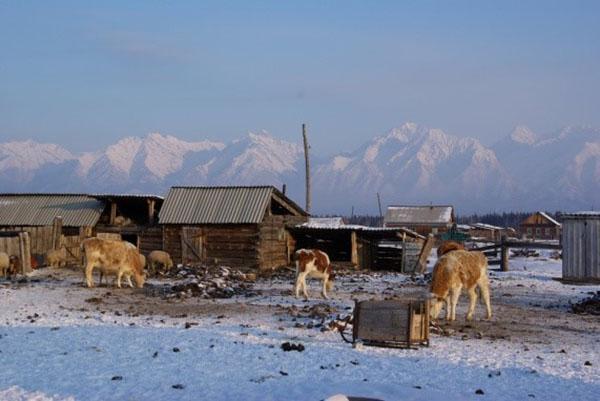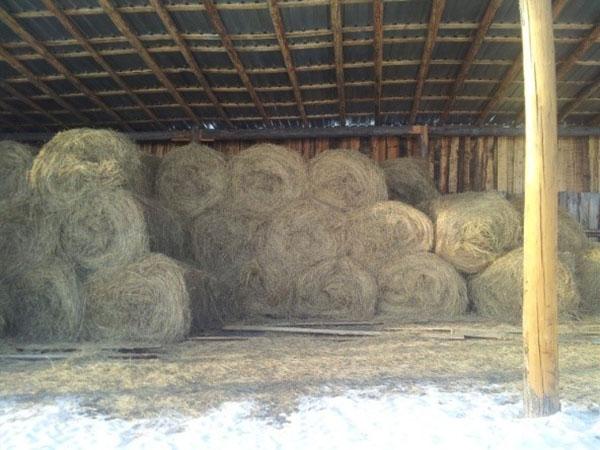What needs to be done at the country house in October?
 For livestock and poultry to survive even the harshest winter months, the owner will have to work hard in the fall. October is considered the best month for preparatory work. It is necessary to prepare food and insulate the habitats of animals. For this, an action plan is developed in advance and all the necessary materials are purchased.
For livestock and poultry to survive even the harshest winter months, the owner will have to work hard in the fall. October is considered the best month for preparatory work. It is necessary to prepare food and insulate the habitats of animals. For this, an action plan is developed in advance and all the necessary materials are purchased.
Feed preparation rules

In October, food is prepared from the remains of the harvest from the garden. Suitable for potatoes, zucchini, corn, carrots, pumpkin, greens and even weeds left after the final weeding. They are suitable for rabbits, goats, sheep and chickens.
To prepare the feed, all selected plants are crushed and placed in a prepared pit. The processing takes place through lactic acid fermentation. The herbal mixture must be moist enough for the process to begin. Add cucumbers or zucchini as needed. But do not overdo it, too much moisture will lead to a loss in feed quality.
The filled pit must be covered. After four weeks, the food is checked for readiness. If it smells of fresh kvass or apples, then it is ready to eat.
How to prepare chickens for winter?
 Chickens spend the winter in an equipped chicken coop... If it is not equipped correctly, the bird will die. When insulating a chicken coop, adhere to the following recommendations:
Chickens spend the winter in an equipped chicken coop... If it is not equipped correctly, the bird will die. When insulating a chicken coop, adhere to the following recommendations:
- Walls, floors and ceilings are upholstered with some kind of material, for example, shingles, foam or specialized insulation. Thick plywood sheets can also be used.
- The walls must be plastered. A mixture of clay, water and sawdust is used as a solution. The thickness of the applied layer should be at least 3 cm. If cracks appear after the main layer has dried, then the plaster is applied again.
- If chickens do not have enough calcium in winter, they will begin to peck at the plaster. Covering the bottom of the wall with plastic panels will help prevent this.
- Will help chickens survive severe frosts infrared heater... This device is considered safe and highly efficient. It consumes a minimum amount of electricity.
- The floor of the chicken coop is covered with sawdust, peat, leaves or straw chaff. This will prevent you from scooping up bird droppings every day. The thickness of the bedding must be at least 25 cm.
In order for the chickens to rush in the winter, they must be fed twice a day, morning and evening.
 Mix industrial compound feed with prepared silage. You can add 30 grams of yeast diluted in one and a half liters of water to the feed. This will increase egg production.
Mix industrial compound feed with prepared silage. You can add 30 grams of yeast diluted in one and a half liters of water to the feed. This will increase egg production.
Preparing livestock for wintering
 Livestock are kept in spacious barns during the winter months. October is the perfect time to prepare a room for cold weather. In this case, the following rules must be observed:
Livestock are kept in spacious barns during the winter months. October is the perfect time to prepare a room for cold weather. In this case, the following rules must be observed:
- All cracks in the barn are carefully caulked. Make sure that there are no cracks in window frames and door frames. They should close tightly. The doors are insulated with straw mats.
- Carefully examine the roof for leaks, cracks and other damage. If necessary, carry out repair work.
- Stalls and feeders require disinfection. To do this, they are first cleaned mechanically, and then treated with specialized means.
- Particular attention is paid to the organization of the litter. It is recommended to use peat, straw or sawdust for this. In extreme cases, use dry leaves or spruce branches. Before stacking, the straw must be chopped so that the length of the segments does not exceed 25 cm.
In addition to arranging a barn, you need to take care of a place for walking animals in the winter. If there are not many cattle, then a plot of 100 square meters will be enough. Fence it up. In winter, it is enough for cattle to walk for a couple of hours.
How to create a comfortable environment for rabbits?
 Experts recommend keeping rabbits outdoors in insulated cages in winter. So the animals will receive a sufficient amount of fresh air, their immunity will be strengthened, and the likelihood of developing infectious diseases decreases. When organizing a home for rabbits, the following recommendations are taken into account:
Experts recommend keeping rabbits outdoors in insulated cages in winter. So the animals will receive a sufficient amount of fresh air, their immunity will be strengthened, and the likelihood of developing infectious diseases decreases. When organizing a home for rabbits, the following recommendations are taken into account:
- The cages must be at least 80 cm above the ground level. They are placed on wooden posts on which the boards are laid. Outside, it is recommended to sheathe the structure with metal sheets.
- The space between the walls and the cage is filled with insulating material. You can use straw, moss, dry leaves, or small twigs. The use of building heat-insulating materials is also permissible.
- The space under the floor of the cages can be insulated with old quilted jackets, blankets and other unnecessary things.
- Artificial heating is optional. It is enough to fill most of the interior space with chopped hay. Rabbits will heat the air with their own breath.
Proper preparation of the farm for the winter will allow the animals to winter calmly. If you follow all the recommendations, chickens will lay, cows and goats will give milk, and rabbits will bear offspring.